Podcast: Download (27.1MB)
Subscribe: Android | Google Podcasts | RSS
Welcome, lovely listeners, to Issue 20 of the Comics Squee podcast. Each show our panelists, punishing evil in the name of the moon, discuss the comic books, graphic novels, and general sequential art geekery that excites them.
I’m Sailor Host Chriss Cornish. Joining me in my righteous fight against boring comics are my Squee Scouts: April Taie, leader of the Geek Girls Meetup in San Diego; and John Oliver, a dark fantasy author online at JohnWOliver.com.
And out of the mists comes the mysterious Sailor Guest, Sarah Jordan. April’s right-hand in the Geek Girls Meetup and fellow comics fan.
Thanks for joining us, Sarah.
In this issue of Comics Squee we have: A romance in lower mathematics ; a Korean tale of teen angst, family, and goblins ; glorious hyper-violence ; and an exploration of crime and purgatory.
As this is our 20th episode, we’ll be celebrating by rolling a twenty-sided die instead of our usual two D6.
-
- Tangent 1: What is Sailor Host’s character class? (starts at 00:01:42.562)
-
John: Dead Letters by Christopher Sebela (writer) and Chris Visions (artist) with colors by Ruth Redmond (starts at 00:01:58.000)
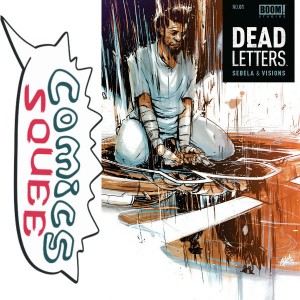 “Glorious hyper-violence”, though a description of Sarah’s squee (Preacher) is a fitting description of Dead Letters as well. Boom! studios has been coming out with a glorious variety of crime and supernatural violence comics and John would like to see them come out with more of them.
“Glorious hyper-violence”, though a description of Sarah’s squee (Preacher) is a fitting description of Dead Letters as well. Boom! studios has been coming out with a glorious variety of crime and supernatural violence comics and John would like to see them come out with more of them.Dead Letters starts with a character who doesn’t know his name; doesn’t know who he is, where is, or how he got there. It’s very Matrix in that it starts with a mysterious phone call saying, “They’re coming for you.”
On the second page Sam tells us, “I remember what bad guys look like. And I can’t shake the feeling that it’s because I look like one too.” This witty dialog. This discovery of the city he’s in. Where is it? What’s going on? Who are these factions, Mr. Jones and Ma, that want him to be on their sides? As the story goes Sam plays the sides off each other, telling each that he’ll be their inside man with the other. And the only answers we get give us more questions.
The twist at the end of issue #1 is a prime example of that. Note that we give the twist away but we’re kind and give you a spoiler warning so you can jump ahead to the next squee If you don’t want it spoiled.
Dead Letters has good use of pacing all around. The art and color are superb and really work well together. Vision’s style has a graffiti quality. It’s like roughs, but finished roughs; lots of black lines, heavy lines. And when things are calm and ‘normal’ the layout is very standard; neat panels with nothing sticking out, even white spacing. But as things get crazier and more frenetic in the story the layout gets crazier. Elements start to extend out of the panels. Things get more jagged. Then panels themselves slide sideways until they’re a ragged series of slashes across black paper. It’s fantastic. Evocative. Both dark AND light.
And we put a word in for the work of letterer Steve Wands. It is NICE lettering.
One last thing that really impressed us about Dead Letters. This is a diverse book. The City is multicultural and has both women and men; it’s populated with the real range of people you see in a major metropolitan area. And the main character is African-American. Or maybe just African. From the book’s language we assume Sam is supposed to be from the U.S.
-
- 1a) Tangent 2: Cwime and Pwuagahtowary (starts at 00:02:05.611)
- 1b) Tangent 3: An artistic aptronymn (starts at 00:02:40.594)
- 1c) Tangent 4: The fantastic aptronymn of Chris Visions revisited (starts at 00:08:40.250)
-
-
Sarah Jordan: Preacher by Gareth Ennis (writer) and Steve Dillon (artist) (starts at 00:09:31.458)
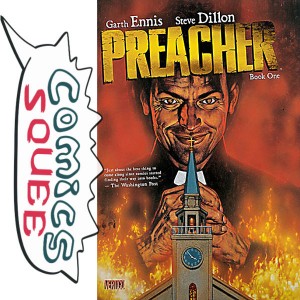 Caveat here that Sarah hasn’t finished the series because it ran for so many years and has a lot of spinning plates in the air. The main themes of Preacher are lots of violence and a play on spaghetti western tropes; protecting yourself as an individual, it’s just you and your gal, etc. A lot of it takes place in the dessert and the color pallet is browns and oranges; overall kind of western-ey.
Caveat here that Sarah hasn’t finished the series because it ran for so many years and has a lot of spinning plates in the air. The main themes of Preacher are lots of violence and a play on spaghetti western tropes; protecting yourself as an individual, it’s just you and your gal, etc. A lot of it takes place in the dessert and the color pallet is browns and oranges; overall kind of western-ey.Our cast are Preacher, Tulip, and Cassidy. Preacher grew up in a terrible family and was forced to be a preacher and is alcoholic. He becomes full of the offspring of a demon and an angel, which gives him The Voice (queue Dune jokes). Tulip, who used to steal cars with Preacher (they have a romantic thing going); she’s a tough character with guns and a knack for taking car of herself. And there’s Casssidy, a vampire from Ireland. Who often has to hide under a blanket in the back of the truck so he doesn’t get burned as they drive around the dessert trying to find God in order to give Him a talking to.
The first book of Preacher is just about setting up the characters, Preacher mostly. When he gets the Genesis power it fries to a crisp everyone in the congregation and destroys the church. So he’s got the law and worst after him.
The art style for Preacher is pretty standard, but it moves along well. The series started in 1995 and it’s kind of a child of that independent comics boom of that era, despite being owned by DC via their Vertigo imprint. It’s one of those series where you’re not incredibly fond of anyone in it, but they’re at least interesting and you want to see how they’ll get out of the next scrape. And you do sort of care about Preacher and Tulip, but you wouldn’t want to hang out or get a beer with them. And you do like Cassidy a lot, since he’s a smart alek and has good dialog.
-
April: The Dot and the Line by Norton Juster (starts at 00:19:43.958)
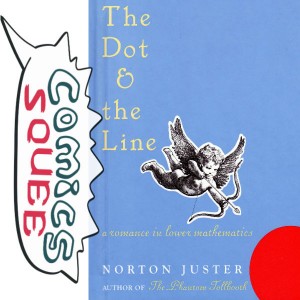 This is a book that April remembers fondly from her childhood. She was reminded about it recently when she saw a Chuck Jones exhibit that included his award winning animated film adaptation of the book.
This is a book that April remembers fondly from her childhood. She was reminded about it recently when she saw a Chuck Jones exhibit that included his award winning animated film adaptation of the book.The Dot and the Line was published in 1963 and is about a line who wants to date a circle, but the circle is in love with a squiggle. It’s filled with silly math puns and combines simple drawn shapes with photographic backgrounds.
We have a serious discussion about whether the line is too good for his lady circle. April finds the dot inconstant. The dot’s so one dimensional *rimshot* (and, yes, it turns out that that is one of the jokes in the book).
-
- 3a) Tangent 5: The Phantom Tollbooth by Norton Juster (movie by Chuck Jones’ studio) (starts at 00:20:34.000)
-
-
Chriss: Dokebi Bride by Marley (starts at 00:28:13.083)
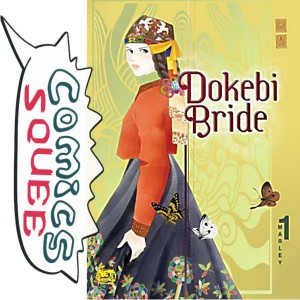 This is a Koren comic (or manhwa) that has been translated into English. You can find it in the manga section of your local bookstore or comic shop; where the store keeps the Asian comics that have been translated. There are 6 volumes.
This is a Koren comic (or manhwa) that has been translated into English. You can find it in the manga section of your local bookstore or comic shop; where the store keeps the Asian comics that have been translated. There are 6 volumes.Dokebi Bride is about a teenage girl who’s grandmother was the shaman for a little fishing village. Because in Korea there’s a long, continuing tradition of female priests. The first volume has a nostalgic, sweetly melancholic tone as the grandmother has died and Sunbi must go live with her absentee father who long ago re-married after her mother’s tragic and mysterious death. The book is mostly Sunbi looking back and remembering her grandmother and it has a folktale-ey atmosphere.
The series gets a little darker as the story moves fully to the big city where Sunbi now lives with her father’s other family, who don’t really want her around. She’s an outsider sort of person who gets along with adults better then with kids her own age. And there’s a great reason, revealed in volume 3, for why the series is called Dokebi Bride (dokebi’s being sort of goblins in Korean folk lore).
Question Time: What Are Your favorite Anime? (starts at 00:34:38.500)
 And now it’s Question Time, when I pose a vaguely thematic query to our panel of squeesters. Feel free to play along at home. Ready?
And now it’s Question Time, when I pose a vaguely thematic query to our panel of squeesters. Feel free to play along at home. Ready?
The Sailor Moon reboot has kicked off. So what are our favorite animes?
- Sargeant Frog
- Gasaraki
- Naruto
- Haibenae Renmai
- Inu Yasha
- Azumangadaioh
- Spirited Away
- Attack on Titan
- Squid Girl
- Elfen Lede
- Samurai Champloo
- Cowboy Beebop
- Ghost in the Shell (the series)
- Angelic Layer
-
- 5a) Tangent 6: Chriss’ esses use the buddy system (starts at 00:47:32.156)
What We’re Looking Forward to Reading Next (starts at 00:48:06.437)

- April: The Comic Book History of Comics
- Chriss Read Comics in Public Day on August 28th (though Chriss holds her San Diego event on the Sunday after).
- John: more issues of The Empty Man
- Sarah Jordan: next volume of Saga










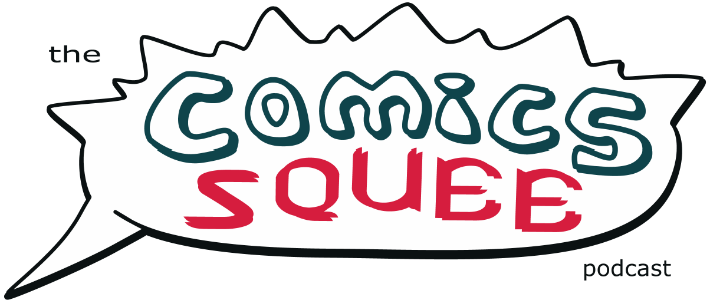

Twitter Feed!
Tweets by @ComicsSquee